| Article ID | Journal | Published Year | Pages | File Type |
|---|---|---|---|---|
| 605336 | Food Hydrocolloids | 2013 | 9 Pages |
The addition of salts to carrageenan and locust bean gum gels functions to improve the characteristics of texture, thereby increasing gel strength. This effect is widely studied in gels of model systems but is studied to a lesser extent in complex systems, such as fruit preserves. The objective of this study was to evaluate the effect of adding salts on the rheological behavior of functional sugar-free guava preserves, as well as to correlate the rheological parameters. To this end, three types of texture properties were analyzed (texture profile, stress relaxation and uniaxial compression) in functional sugar-free guava preserves prepared with different concentrations of KCl and CaCl2 salt. The analyses were performed with a texturometer (Stable Micro Systems, Model TA - XT2i), and the parameters were analyzed using a Scott-Knott test at 5% probability, principal components analysis and Pearson correlation. CaCl2 was more effective for improving the characteristics of texture, especially gel strength (concentration near the F3: 0.33%), whereas KCl addition degraded gel strength. In the analysis of test relaxation, the Maxwell model parameters provided better discrimination between samples than the Peleg model parameters. Positive and negative correlations were observed, and the parameters of hardness, adhesiveness and elastic modulus ideal (E1) were the most correlated with other rheological parameters.
Graphical abstractFigure optionsDownload full-size imageDownload as PowerPoint slideHighlights► The study of the rheological behavior of functional sugar-free guava preserves in the presence of salts was proposed. ► The rheological behavior was studied using two different concentrations of salts: calcium chloride and potassium chloride. ► The use of calcium chloride improves the rheological characteristics functional sugar-free guava preserves.
